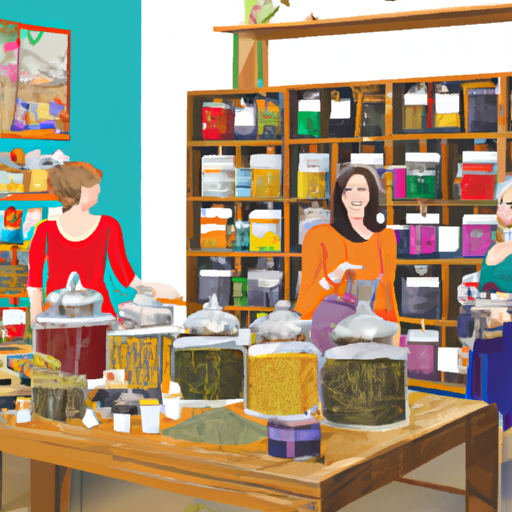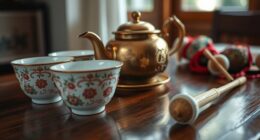For centuries, herbal tea has been enjoyed for its numerous health benefits.
One particular herb, St. John’s Wort, has gained popularity for its potential to promote relaxation and improve mood. In fact, studies have shown that St. John’s Wort may be effective in treating mild to moderate depression.
If you’re interested in harnessing the power of this amazing herb, I’m here to guide you through the process of making a cup of herbal tea with St. John’s Wort. From gathering the necessary ingredients to brewing the perfect cup, I’ll provide you with step-by-step instructions to ensure your tea is both delicious and beneficial.
So, grab your favorite mug and let’s embark on a journey to discover the wonderful world of St. John’s Wort tea.
Key Takeaways
- St. John’s Wort tea has health benefits and promotes relaxation and improves mood.
- St. John’s Wort tea increases serotonin, dopamine, and norepinephrine levels in the brain.
- It is important to consult a healthcare professional before using St. John’s Wort tea, especially if taking medications.
- To make St. John’s Wort tea, gather fresh plants, dry them, and steep them in hot water for 5-10 minutes.
Understanding the Benefits of St. John’s Wort
Now let’s dive into the amazing benefits of St. John’s Wort and why it’s such a popular choice for herbal tea enthusiasts!
St. John’s Wort has been used for centuries in traditional medicine for its numerous benefits, particularly for mental health. It’s known to help alleviate symptoms of mild to moderate depression and anxiety, promoting a sense of calm and well-being. This herb contains active compounds such as hypericin and hyperforin, which are believed to increase the levels of serotonin, dopamine, and norepinephrine in the brain.
However, it’s important to note that St. John’s Wort may interact with certain medications, such as birth control pills and antidepressants, so it’s crucial to consult with a healthcare professional before incorporating it into your routine. Additionally, some individuals may experience side effects like photosensitivity or gastrointestinal discomfort, although these are generally mild and rare.
Gathering the Necessary Ingredients
First, gather all the essential elements needed for this soothing and satisfying St. John’s wort infusion. To start, you’ll need to harvest fresh St. John’s Wort plants. Look for plants that have bright yellow flowers and make sure to collect them on a sunny day when the flowers are fully open.
Once you have your St. John’s Wort, dry the flowers and leaves by spreading them out on a clean, dry surface for a few days.
Next, you’ll need to select the right type of herbal tea to pair with the St. John’s Wort. Chamomile and lavender are excellent choices as they complement the earthy and slightly bitter flavor of the herb. Make sure to use high-quality loose leaf tea for the best results.
With these ingredients gathered, you’re ready to move on to the next step in creating your cup of herbal tea with St. John’s Wort.
Preparing Your Tea Infusion
Once you’ve gathered all the necessary ingredients, get ready to indulge in a soothing and invigorating infusion of St. John’s Wort that will transport your taste buds to a state of pure bliss. To prepare your tea infusion, it’s important to understand the steeping time and select the right teapot. Steeping time plays a crucial role in extracting the maximum flavor and benefits from the St. John’s Wort. For a perfect cup of herbal tea, steep the dried flowers and leaves in hot water for about 5-10 minutes. Adjust the steeping time based on your personal preference for a stronger or milder taste. When it comes to selecting the right teapot, choose one made of heat-resistant glass or ceramic to retain the heat and flavor. The transparent teapot allows you to admire the beautiful color of the infusion as it brews. Enjoy the process and savor every sip of this delightful herbal tea.
Markdown Table:
| Steeping Time | Teapot Selection | Benefits |
|---|---|---|
| 5-10 minutes | Heat-resistant glass or ceramic | Maximum flavor extraction |
| Transparent | Admire the infusion color |
Brewing the Perfect Cup of St. John’s Wort Tea
To achieve the perfect infusion of St. John’s Wort, it’s essential to brew your tea with precision and care. Understanding the brewing process is crucial in order to fully enjoy the benefits of this herbal tea. Here are a few tips to help you brew the perfect cup:
-
Start by selecting the right tea leaves. Look for high-quality St. John’s Wort leaves that are fresh and vibrant in color.
-
Measure the correct amount of leaves for your cup and place them in a tea infuser or teapot.
-
Heat water to around 200°F (93°C) and pour it over the leaves.
-
Let the tea steep for about 5 minutes to allow the flavors to fully develop.
-
Avoid over-steeping, as this can result in a bitter taste. Adjust the steeping time based on your preference.
-
Finally, remove the leaves or strain the tea to prevent further steeping.
By following these steps, you’ll be able to brew a delicious cup of St. John’s Wort tea that’s both soothing and beneficial to your well-being.
Enhancing the Flavor of Your Tea
Indulge your taste buds and elevate your tea-drinking experience by infusing your brew with delightful flavors. Adding natural sweeteners is a fantastic way to enhance the taste of your herbal tea. Try adding a teaspoon of honey or a sprinkle of stevia for a touch of sweetness.
If you prefer a more tangy flavor, a squeeze of lemon or a dash of orange zest can do the trick. Don’t be afraid to get creative and experiment with different steeping times. Steeping your St. John’s Wort tea for a shorter time can result in a milder flavor, while a longer steeping time can produce a stronger and more robust taste.
So go ahead, let your taste buds be your guide and discover the perfect combination of flavors for your cup of herbal tea.
Exploring Different Variations and Blends
Discover the endless possibilities of exploring different variations and blends, and let your taste buds embark on a flavorful journey. When it comes to making herbal tea with St. John’s Wort, there are so many different herbal blends and flavors you can experiment with.
Here are four exciting variations to try:
-
Chamomile and St. John’s Wort: This combination creates a soothing and calming blend that’s perfect for relaxation.
-
Peppermint and St. John’s Wort: The refreshing taste of peppermint complements the earthy flavors of St. John’s Wort, resulting in a revitalizing blend.
-
Lemon and St. John’s Wort: Adding a slice of lemon to your tea not only enhances the flavor but also adds a subtle citrusy twist.
-
Lavender and St. John’s Wort: This floral blend offers a delicate and aromatic experience, making it ideal for winding down.
Don’t be afraid to mix and match different herbs to create your own unique blends. Let your creativity guide you as you explore the vast world of herbal tea flavors.
Tips for Maximizing the Benefits of St. John’s Wort Tea
Now that we have explored different variations and blends of herbal tea with St. John’s Wort, let’s dive into some tips for maximizing the benefits of this powerful tea. When it comes to St. John’s Wort tea, it’s important to understand how to maximize its effects while being aware of potential side effects.
To get the most out of your St. John’s Wort tea, consider the following tips:
- Steep the tea for the recommended amount of time to extract the maximum amount of beneficial compounds.
- Store your tea in a cool, dark place to preserve its potency.
- Start with a lower dosage and gradually increase it to avoid any potential side effects.
- Consult with a healthcare professional if you are taking any medications, as St. John’s Wort can interact with certain drugs.
By following these tips, you can ensure that you are maximizing the effects of St. John’s Wort tea while minimizing any potential side effects. Remember, it’s always important to listen to your body and consult with a healthcare professional if you have any concerns.
| Maximizing Effects | Potential Side Effects |
|---|---|
| Steep for recommended time | Interacts with certain drugs |
| Store in a cool, dark place | May cause photosensitivity |
| Start with lower dosage | Can cause gastrointestinal upset |
| Consult with healthcare professional | Possible allergic reactions |
Frequently Asked Questions
Can St. John’s Wort tea be used to treat depression?
St. John’s wort tea may have potential side effects like photosensitivity and interactions with medications. While it’s considered a natural remedy for depression, its effectiveness compared to other remedies is still debated.
What is the recommended dosage of St. John’s Wort for tea?
The recommended dosage of St. John’s Wort for tea is 2-3 grams of dried herb steeped in hot water for 10-15 minutes. While generally safe, potential side effects include photosensitivity and interactions with certain medications.
Can I consume St. John’s Wort tea if I am taking other medications?
Yes, it is important to be cautious when consuming St. John’s Wort tea while taking other medications. It can interact with certain medications, potentially leading to adverse effects or reducing their effectiveness. Always consult with a healthcare professional for personalized advice.
Can I use dried St. John’s Wort leaves to make the tea?
Using dried St. John’s Wort leaves for tea is like infusing your cup with the sun’s rays. It amplifies the benefits of St. John’s Wort tea, promoting relaxation, mood improvement, and overall well-being.
Can St. John’s Wort tea be consumed by pregnant or breastfeeding women?
St. John’s Wort tea may not be safe for pregnant or breastfeeding women due to potential safety concerns. It may also interact with certain medications. It is important to consult with a healthcare professional before consuming this tea.
Conclusion
In conclusion, making a cup of herbal tea with St. John’s Wort is a delightful and beneficial experience. By understanding the benefits of this herb and gathering the necessary ingredients, you can easily prepare a tea infusion.
Brewing the perfect cup requires patience and attention to detail, but the end result is worth it. Enhancing the flavor with honey or lemon adds a touch of sweetness. Don’t be afraid to explore different variations and blends to find your perfect cup of St. John’s Wort tea.
Remember, as the adage goes, "A cup of tea is like a warm hug for the soul." So, sit back, relax, and enjoy the soothing properties of this wonderful herbal tea.










